This post is also available in:
 English
English  Italiano (Italian)
Italiano (Italian)
The article discusses the main ways of filtering drinking water at home: a filtering jug, flow filter, and reverse osmosis installation. Photos and technical details courtesy of Aquaphor.
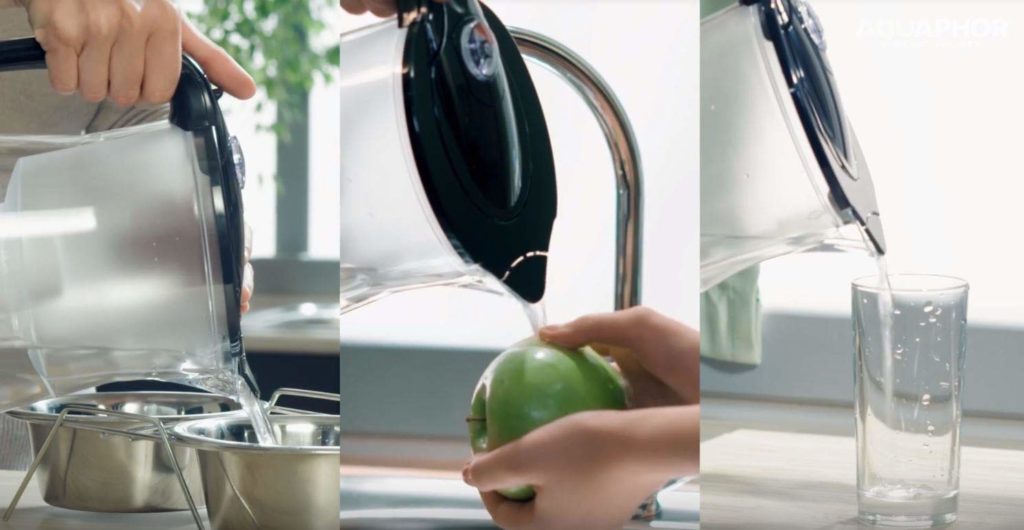
WHY IT’S ADVISABLE TO PURIFY TAP DRINKING WATER?
In most developed countries, there are standards for drinking water supplied to residential buildings. However, water quality control is usually carried out at the exit from a centralized filtration system. And then the water goes a long way until it reaches the tap in your kitchen. This path runs through many kilometers of pipes, most often laid many years ago. Some of these pipes are iron, hence a metallic taste, rust, and other oxides appear in the water. Copper pipelines are also found in homes – they themselves are durable, but oxidized copper is also not good for the body.
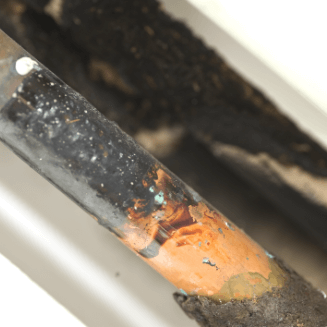
Lead and heavy metals 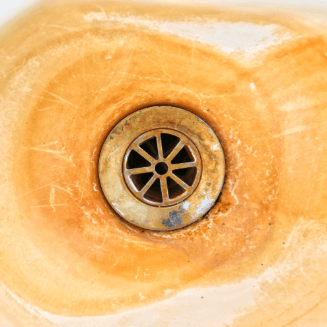
Iron rust 
Hard water
In addition, dirt accumulates in any pipes (including modern polymer pipes). Where does it come from? In case of accidents and damage to pipes underground, the soil erodes, and together with water it enters the pipe and spreads throughout the entire branched system. When repairing a damaged pipe, of course, it is replaced, but it is no longer possible to flush the entire system perfectly. Imagine how much sediment settles in pipes in 10 or 20 years! This dirt is the habitat of various bacteria and other microorganisms. If the water is chlorinated, this inhibits their development, but chlorine and chlorides in themselves are harmful substances.
Even if the water in the tap meets basic hygiene standards, its appearance, smell and taste may be far from ideal. In particular, the calcium content may not exceed the norm, but it can leave white marks on dishes, precipitate when boiling, create scale and spoil your household electrical appliances. In addition, excessively hard water negatively affects the life of the body, as it causes a violation of the acid-base balance in physiological fluids.
Thus, if you want to avoid all these troubles, to feel the true taste of your favorite drinks, to protect your family and children from the long-term consequences of drinking contaminated water, there are only two solutions – either buy bottled water (from a trusted supplier) or fix existing water on the spot . The second option allows you to get the required amount of clean drinking water right in your home. The price of one liter of such water (even when installing quite complex and expensive systems) in the future will be ten times cheaper than bottled water.
Filters for drinking water help reduce the number of impurities, ensure the elimination of pathogenic bacteria, and also significantly improve the taste. Proper purifying favorably affects the composition of the water and guarantees the health and well-being of those who regularly use water.
DIVERSITY OF FILTERING SYSTEMS
The most popular types of drinking filters:
filtering pitcher (jug);
flow (in-line) filter;
reverse osmosis system.
FILTERING PITCHERS

Some people hesitate to install a special fixed filter for water, so they prefer portable filter jugs. Amazingly, this simple and inexpensive thing can eliminate most of the insoluble inclusions and significantly improve the water quality. A pitcher can also be useful as a temporary solution, for example, when going on vacation to an unfamiliar area, where the composition of the water is likely to differ from the usual.
There is a wide variety of filter pitchers, and we will examine them in more detail in another review.
Advantages of filter pitchers:
- low price (for example, fairly high-quality jugs Aquaphor Amethyst may cost less than 20 euros;
- the ability to use them without installation, immediately after purchase;
- sufficiently high efficiency of cleaning the main pollution;
- a wide variety of shapes, volumes and colors (compare, for example, Aquaphor Prestige and Aquaphor Onyx )
Disadvantages of filter pitchers:
- this type of water treatment does not provide a sufficient level of filtration for fine and dissolved contaminants;
- the amount of filtered water is quite limited;
- despite the fact that this option seems economical, filter cartridges will have to be changed quite often (every 1-3 months or 200-350 liters).
FLOW (IN-LINE) FILTER
To clean drinking water in your house, now you do not need bulky systems. It is enough to place an additional faucet next to the usual tap, and place the filter system under the kitchen sink. Filters for drinking water “under the sink” get the highest place in the ranking of the best cleaning products because of their ease of use and effective results.
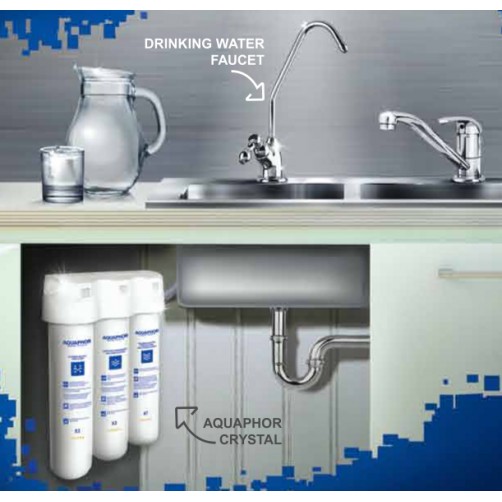
A compact household appliance can improve the quality of the water used and is much more effective than a filter jug. For example, the Aquaphor Crystal three-stage ultrafiltration system is effective against chlorine, lead, heavy metals, pesticides, phenol, colloidal iron and other impurities larger than 0.8 micrometers. As a rule, the first two stages of purification eliminate fine particles and impurities, and the last stage (made using carbon-block technology from activated coconut carbon) – finishes and eliminates odors.
Most people, who have some housekeeping skills, along with instructions and appropriate tools, do the job of installing filters on their own, but it is recommended (and sometimes even required by local rules) that a qualified plumber do this job. Usually, installation takes 1-2 hours.
The performance of such a filter is more than 3 liters per minute.
Frequency of replacement of filter elements – from 6 to 12 months.
The resource of filtering elements is up to 6000 liters.
Periodic replacement of filter elements is not difficult and can be carried out independently.
The price of such systems is usually within 100 euros.
REVERSE OSMOSIS SYSTEM
The most thorough purification method is a filter with reverse osmosis system.
Water in such a system is under pressure and, in addition to pre-filters of various porosity and structure, passes through a special membrane. A water molecule (0.3 nm in size) passes through this membrane, but the majority of chemical impurities and inclusions of biological origin, in particular microorganisms and viruses (sizes from 20 to 500 nm), do not pass. For example, such a filter can trap cholera bacteria or hepatitis viruses.
This method is especially recommended if the quality of the source water is unstable or cannot be controlled (for example, old water pipes, as well as boreholes and wells in rural areas).
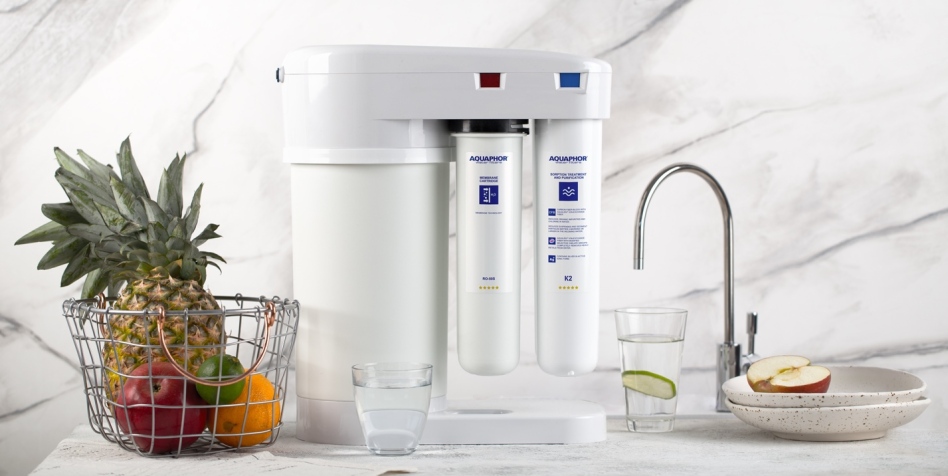
Typically, a reverse osmosis system includes two to three cartridges with pre-filters, a reverse osmosis membrane, a storage tank, a post-filter, and a separate faucet for purified water. A storage tank is necessary because filtration is quite slow, and it is convenient to have a stock of purified water (4-8 liters), which can be used immediately. If the system pressure is too low, a pressure boost pump is also required; it can either be included in the system immediately or delivered, if necessary, separately, such as the Aquaphor Booster Kit.
If the source water is dirty or has a lot of insoluble impurities (for example, sand), a pre-filter is installed in front of the system. If microorganisms are likely to be in the water, then the system is supplemented with a bactericidal ultraviolet lamp.
Frequency of replacement of filter elements – from 6 to 12 months
The resource of filtering elements is up to 8000 liters.
Routine maintenance and replacement of filter elements is not difficult and can be carried out independently.
Reverse osmosis systems also have disadvantages:
- unlike conventional filters, not all water passes through the system – during operation, a certain amount of water with concentrated impurities is formed, which usually outflows into the drain; that is, producing 1 liter of super-pure water requires from 2 to 4 liters of the source. Outflow water is not dangerous, it is even cleaner than the original tap water, and it can be used for technical purposes or for secondary filtration;
- the reverse osmosis system requires a certain water pressure for operation, usually in the range of 2.5 – 6.0 bar; if the initial pressure is too small – a booster is required, and if too large – a pressure reducer;
- A relatively complex system requires certain skills in installation and maintenance. Most people, who have some housekeeping skills, along with instructions and appropriate tools, do the job of installing filters on their own, but it is recommended (and sometimes even required by local rules) that a qualified plumber do this job. Usually, installation takes 1-2 hours, including the initial washing of the filters.
Quality reverse osmosis systems can cost anywhere from 150 to 700 euros.
Some skeptics believe that the water from reverse osmosis systems is too pure, does not contain minerals, and has no taste. Yes, in such water, there are practically no impurities, which means there are no salts and minerals. It is just water, with the taste of water and without any foreign smell, and it perfectly quenches thirst. Scientific studies show that it is impossible to overestimate the role of water as a solvent and the environment for all physiological processes. However, most of the nutrients, vitamins, and minerals a person receives not from water, but from food.
Of course, if you are used to drinking quality mineral water and you like its taste, you can continue to drink it. But in order to find out the true taste of your favorite dishes and drinks (coffee, classic and herbal teas), it is better to use absolutely pure water for their preparation. Water without impurities is also preferable for cooking food and drinks for children and people suffering from allergies and various diseases.
In modern reverse osmosis systems, the aforementioned disadvantages have already been partially eliminated. For example, in the Aquaphor Morion DWM-101S, the minimum pressure requirements are reduced to 1.86 bar. In addition, this system facilitates the process of replacing cartridges, and it is also possible (as a finishing post-filter) to use elements with the addition of minerals, such as magnesium, which is good for the heart.
The features of various reverse osmosis systems are discussed in more detail in another article.
CONCLUSION
Which system to choose? The answer to this question depends on the quality of the source water, the task and the required amount of treatment.
If there is a need to improve the properties of water urgently and without capital expenditures, and the source water is safe enough, then the easiest way is to buy a filtering jug. Also, this is a good option for temporary housing or on a trip.
If the source water is safe enough and you need more water (family, more or less permanent residence, or a small cafe), then this or that flow filtration system is suitable.
If the quality of the source water is unstable or in doubt, or if you need perfectly pure water, free of 99.9% of all known impurities, then the best solution would be to install a reverse osmosis system.
The main conclusion that can be drawn: any of the considered filtration systems improves water quality and, therefore, brings long-term health benefits.
Photos and technical details courtesy of Aquaphor, ProMarket.
If you have a related business (for example, a store for household goods and household appliances, a pharmacy or a business for plumbers), you can offer your customers a new high-quality and profitable product. For wholesale discounts and a sales representative deals, please write to ProMarket by
Ⓒ 2020-2025 ProMarket – all rights reserved.
This post is also available in:
 English
English  Italiano (Italian)
Italiano (Italian)





One Reply to “DRINKING WATER PURIFIERS AND FILTRATION SYSTEMS – A COMPARATIVE REVIEW”